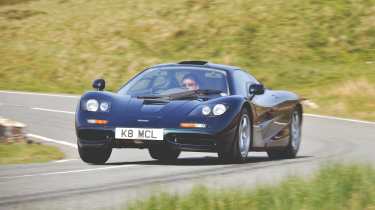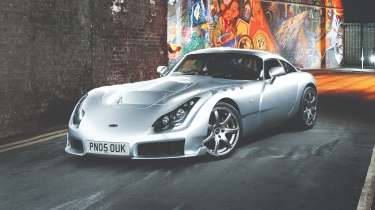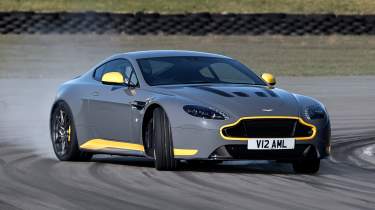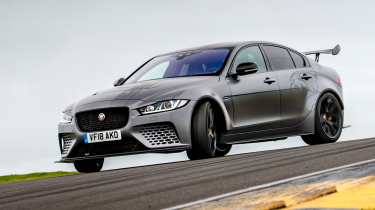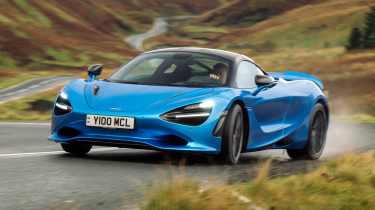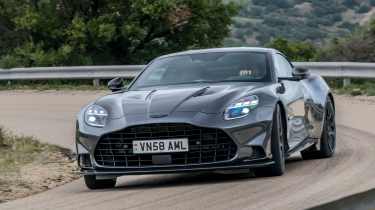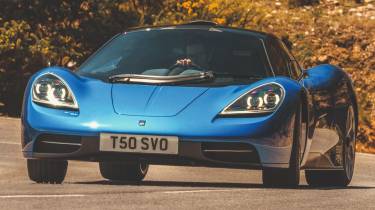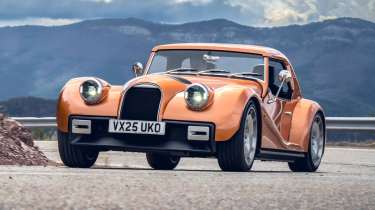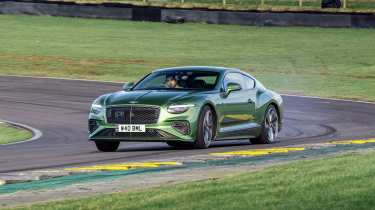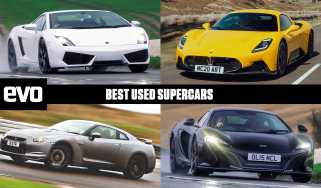Best British cars – the finest driver’s cars to come out of Great Britain
Britain has produced countless performance car icons over the years – these are evo’s favourites
While the British car industry isn’t known for consistently turning out back-to-back group test winners, it has produced some of the world’s most revered performance cars over the years; models that capture the innovation, engineering brilliance and charm it takes to deliver the Thrill of Driving in its purest form.
When viewed through an evo lens, narrowing the portfolio down, rather than struggling to make it up to ten, is the problem at hand. Read on for a rundown of the best British performance cars we’ve driven – ranks that the new Aston Martin Valhalla and McLaren W1, as well as the next wave of Lotus and Jaguar models, will surely be hoping to join.
Top ten British cars
- McLaren F1
- Lotus Elise S1
- Caterham Seven evo25
- TVR Sagaris
- Aston Martin V12 Vantage S
- McLaren P1
- Jaguar XE SV Project 8
- McLaren 750S
- Aston Martin Vanquish
- GMA T.50
- Morgan Supersport
- Bentley Continental GT Speed
McLaren F1
Prices from over £10million
Pros – Still the ultimate supercar, over three decades on
Cons – 90s headlights and brakes
We start with perhaps the ultimate British car – the McLaren F1. When Gordon Murray lays out a design brief, only the technology of the day will get in the way of him seeing through his vision. With the F1, that brief was to create the ultimate road-going supercar.
The engine – Paul Rosche’s glorious 618bhp S70/2 6.1-litre BMW M V12 – and six-speed manual transmission take it most of the way, but they really are the cherry on the cake that is the F1’s entire constitution. From the steering, to the handling, even to the view out and its compact dimensions. It’s all a product of Murray’s fanatical devotion to light weight and driver interaction, and his disdain for lazy engineering. The result is a car that, even over 30 years on from its introduction, sets standards when it comes to the Thrill of Driving.
‘Turn in, feel the slight push of the nose as the wheel goes a fraction lighter in your hands, a little lift of your right foot to transfer the weight and then back down for a quick bark of throttle to unstick the big 315-section rears. They’ll spin up quickly and the tail swings fast, but the steering knows what to do and you can let the perfect circle run through your hands into opposite lock as the car arcs round behind you. If you’ve got it right you’re now sliding an F1 and happier than Larry.’ – Henry Catchpole, evo contributor and former features editor, who tested the F1 against its spiritual successor, the Gordon Murray T.50.
Alternatives to the McLaren F1
Alternatives to the McLaren F1 can vary, depending on your motivation for having one. As a financial asset, a Rembrandt would do the trick. As a driving machine? Only the GMA T.50 has exceeded it over the last 30 years, and rightly, poetically so. Perhaps a Ferrari F50, Porsche Carrera GT or Pagani Zonda F are along the same carbon-tubbed, multi-cylindered, naturally aspirated, rear-drive, manual-transmissioned lines.
Lotus Elise S1
Prices from £16k
Pros – Light and lithe
Cons – Patchy fit and finish
It’s arguable that a number of principles that drove the conception of the McLaren F1 found a home in the Lotus Elise, which is why like the F1, it remains a high watermark today. Small, lightweight, tactile and compliant – as a tool to pick apart a dipping, undulating British country road, the Lotus Elise was a revelation.
A shoo-in, then, as one of the best British cars. But it’s not just the sum of its parts that makes the Lotus Elise so compelling; it’s the fascinating execution and journey to that end result. Yes, the F1’s place as the first all-carbon car makes it incredibly innovative – as well it should have been given it cost over £600,000 when new. But the Elise, for its price certainly, was arguably just as ingenious, debuting the bonded extruded aluminium structure that went on to define an entire generation of Lotus sports cars.
Aston Martin adopted a similar construction method that it continues to employ today, too. The lightest and most pure Elise is the Series 1, which weighed just 731kg and used a compact, lightweight Rover K-series engine, perfectly in-keeping with the car’s philosophy.
‘It will kick the tail wide if you’re keen, and do it tidily, but that’s not really its style. It’s the Elise’s deftness, its effortlessness across the ground that was unique and compelling back in 1996 and still is now. Back then, I got as many people into it as I could and it entertained and delighted them all, whether they drove or rode in it.’ – John Barker, evo co-founder and editor-at-large, who’s driven early Elises multiple times since the model’s launch in 1996.
Alternatives to the Lotus Elise S1
The Lotus Elise S1 treads a very careful line, combining the raw, unfettered interaction of a road-going racer like a Caterham, with just a hair more refinement, thanks to its closed body and road-biased, compliant suspension setup. Exact alternatives are few (okay, a Vauxhall VX220 is more or less exact) but we can say, Elise drivers would enjoy time behind the wheel of a Caterham, or a Mk3 Toyota MR2, or anything else that champions light weight, diminutive proportions and uncompromising driver interaction.
Caterham Seven evo25
Prices from £41,990 (Seven 420)
Pros – As raw as driving gets without rubbing your hands along the road
Cons – Far from an everyday driver’s car
British engineers love extremes as much as they love minimalism and as such, the Caterham Seven makes the Lotus Elise look like a Range Rover.
You are that much closer to the elements, that much closer in literal reach to the road passing beneath you and the noises you associate with motorised transport are that much louder; of the engine, the gearbox, the wind passing all around and the road surface grazing the tyres. The Caterham Seven is a masterclass in the essentials of the Thrill of Driving, and this is true from the basic three-cylinder 170 version, right up to the utterly manic 620R. The perfect performance car on which to base a special edition celebrating 25 years of evo, then.
It figures that the Caterham Seven evo25 should find a place on our list of the best British cars, because it’s our idea of the perfect Seven for use on both the road and on track. It combines a 210bhp Duratec motor, five-speed manual gearbox and 420 Cup suspension with comfort seats, the more practical ‘Trackday’ roll-cage and full weather equipment – heater and all. Caterham perfection.
‘I’d worried that the weighty steering would put a dampener on its on-limit playfulness but once I had a feel for the lines, it all became about the rear and managing mild, power-induced slip. It was brilliant fun, tactile and transparent, carrying speed where bigger, heavier cars were tentative, its braking points tens of yards after those same cars.’ – John Barker, evo co-founder and editor-at-large, who drove the Caterham Seven evo25 numerous times during our long-term test.
Alternatives to the Caterham Seven
The best alternative to a Caterham Seven is usually another Caterham Seven, albeit a different flavour. Perhaps a faster one, perhaps one with more track-focused suspension, or one with the wide-body. Further affield, an Ariel Atom comes close, as does a GBZ Zero or an original Lotus Elise.
TVR Sagaris
Prices from £80k
Pros – An intoxicatingly thrilling sports car, to drive and look at
Cons – A bit garish, usual TVR reliability caveats
TVR is on the other end of the spectrum to our other entries thus far, putting a particularly English spilt-pint, Marbella tan flavour of flamboyance at the top of its list of priorities over engineering excellence and outright precision. But over the years it’s turned out some glorious machinery, with the TVR Sagaris the pinnacle of the breed. It was the last TVR to be produced and benefitted from a number of detail changes that made it less quirky to live with and more functional.
While it probably still wasn’t enough to tempt buyers out of their BMWs and Porsches, it had much going for it. A low kerb weight of under 1100kg and a sublime straight-six that doled out over 400bhp endowed the Sagaris with a claimed 3.7sec 0-62mph time and a top speed of 185mph – thoroughly modern performance but achieved without modern niceties such as airbags, traction control or even ABS.
It could be a handful on the road and it didn’t respond well to being taken by the scruff of the neck, but if you were more measured with your inputs you could enjoy a whole lot more of what it had to offer – precise and instant turn-in, a balanced chassis and phenomenal pace.
‘There is considerable performance on offer, but only if the driver is first willing to invest the effort. That must make this deranged TVR one of the most absorbing performance motoring experiences of recent decades.’ – Dan Prosser, former evo road test editor, who drove the Sagaris in the UK.
Alternatives to the TVR Sagaris
The best alternative to the TVR Sagaris when it was new was of course, the TVR Tuscan 2. Nobody else made anything with the same raw, hard-hitting character for the price. A BMW Z4 M, with its S54 straight-six, is a pleasant approximation, albeit a more serious one with less of a sense of humour. Likewise a Porsche Cayman, which is a better car in every way but without the bombastic personality of the TVR.
Aston Martin V12 Vantage S
Prices from £70k
Aston Martin is perhaps the most beloved British brand. Indeed for all its years (most of them) of unprofitability, it’s survived by producing achingly desirable and beautifully designed GTs that even the hard-headed finance types of a certain giant American motoring monolith couldn’t ignore.
But in spite of how tumultuous the Ford era was, it arguably gave way to Aston’s very best era so far; that of the 5.9-litre V12 and the aforementioned VH aluminium platform. The car that perhaps best sums up that era and is probably an example of Aston at its best, is the V12 Vantage S. We love the V12 Vantage at evo. Such a big powerful engine in such a small car was always going to be hilarious, but not necessarily excellent dynamically. Thankfully, the V12 Vantage turned out to be almost precision-honed for the job of delivering driving thrills.
The V12 Vantage S then double-honed it, first puffing the voluminous V12 up to 565bhp, then adding a seven-speed manual transmission. Perfect? No – that ‘box is a bit notchy – but Astons, especially the V12 Vantage, endear in a way that isn’t contingent on objectivity.
‘Crowbarring 50 per cent more cylinders into a small car is childishly appealing to any enthusiast, but there was always the danger that Aston’s engineers could have created a caricaturish monster. They haven’t. It’s got character yet it’s refined; it’s got instant pace yet a depth that makes you want to live with it. Debonair and unafraid, it feels like a truly British Aston Martin.’ – Henry Catchpole, evo contributor and former features editor, who tested the V12 Vantage S on the road in the UK and on the launch.
Alternatives to the Aston Martin V12 Vantage S
For front-engined V12 thrills there is only one alternative: Ferrari, probably a 599 or an F12 for V12 Vantage S money. Both are bigger and not as agile as the Vantage. Look to the US and the C7 Corvette Z06 and SRT Viper offer similar silhouettes and performance levels.
McLaren P1
Prices from £1.5million
Pros – Enormously capable and fast yet exploitable and adjustable
Cons – Engine more industrial than lusty
Wrongly billed as an F1 successor when it arrived in 2012, the McLaren P1 was in a way lucky to escape the shadow of the Almighty. But then, to say it was luck would be to do the P1 a disservice, because it’s one of the most thrilling hypercars of any era, let alone its own. It was a first taste of McLaren Automotive at its best, with as much of a sense of humour as it has absolute technical majesty. A carbon monocell chassis, interlinked hydraulic suspension with variable ride height, Akebono carbon-carbon brakes and a hybridised powertrain with torque fill are just some of the highlights.
But translated out of Ron Dennis speak, it’s a car that can drop on its shocks and pop its enormous hydraulic DRS-capable wing ready for a monstrous lap, dropping the jaws of all in its presence in the process before even turning a wheel. It’s a car that has a combined 907bhp, that can eviscerate the rear tyres and dissolve like putty in the driver’s hands for spectacular big smokey drifts, having only just broken a record time the lap before.
It’s a technical tour de force that engages the driver in the most binary, interpretable way, presenting a banquet of awe and adrenaline at every rung of its performance envelope, from winding country roads to the very fastest Grand Prix circuits. The P1 is bleeding-edge motorsport science – itself a craft Britain masters – and quintessential hypercar theatre, triple distilled on four wheels wrapped in flow-formed carbon.
‘Driving a fully lit P1 has been likened to riding a firework. It’s intense and exhilarating and, if you attempt to deploy the IPAS battery boost or trigger the DRS system, a stern test of your ability to multi-task. Of course both are gimmicks, but I’d be lying if I said there isn’t endless fun to be had from feeling the surreal thump of battery power supplementing the on-boost V8. It’s genuinely like you’ve pressed the fast-forward button. Likewise, using the DRS button to wave bye-bye to whatever’s in your mirror is childishly amusing. Who says McLaren doesn’t have a sense of fun?’ – Richard Meaden, evo co-founder and editor-at-large, who drove the P1 on its launch at Yas Marina and numerous times since on track and on UK roads.
Alternatives to the McLaren P1
The P1 is a car as much defined by its rivals as it is its own towering technical and experiential offering. Arriving more or less at the same time as the Ferrari LaFerrari and the Porsche 918 Spyder, there was no escaping comparison. Which is fine, because they all brought something unique and special to the fight. On the outskirts were Pagani and Koenigsegg, at the time trotting out derivations of their Huayra and Agera hypercars.
Jaguar XE SV Project 8
Prices from £120,000
Pros – The ultimate road and track Jaguar
Cons – It’s pretty extreme for some tastes
In its standard form the Jaguar XE wouldn’t be getting close to a place on this list. That speaks volumes as to the extent of its transformation into the Project 8. This Jaguar SVO skunkworks machine is a genuinely serious performance saloon.
Project 8 is a machine that wears its heart on its sleeve – there’s no chance you could call the huge front and rear spoilers or blistered arches subtle – but they’re there for a purpose. And that’s to make the XE seriously fast. The body is almost exclusively made from carbonfibre or aluminium, the track’s wider and those 20-inch rims are wrapped in Cup 2s and hide 400mm front discs. Performance is courtesy of a 592bhp V8 which brings up the benchmark sprint in a blink-and-you’ll-miss-it 3.3sec – impressive for a 1.8-ton machine. But it’s not the Project 8’s straight line speed that’s its most impressive party trick as on the road it’s rapid, responsive and remarkably refined.
It feels light on its toes and the extremely precise steering allows you to perfectly position the big Jag. It’s balanced, has colossal grip thanks to its four-wheel drive and Cup 2 rubber (although it can be a little skittish in the wet) and the brakes wash off speed without complaint. It’s an amazingly rounded machine, and if you forgo the Track Pack that ditches the rear seats in favour of a roll cage, you could almost call it practical family transport.
‘Everything about it marries exaggeration with a tenacious accuracy. So often, shouty V8s and blistered, swollen bodywork are used to distract from a dynamic repertoire that’s big on brute force but actually rather blunt beneath the surface. The Project 8 balances shock and awe with an inherent sharpness that’s captivating.’ – Jethro Bovingdon, former evo contributor, who tested the Jaguar XE SV Project 8 against the BMW M3 CS and Alfa Romeo Giulia GTA.
Alternatives to the Jaguar XE SV Project 8
You wouldn’t imagine a left-hand-drive super saloon with the option of omitting the back seats would have many direct rivals but such is the car industry’s fetish for a niche, it does. That came in the form of the Alfa Romeo Giulia GTA, which could be had with as ludicrous an aero kit as the Jag and without the back seats, in Giulia GTAm form. An M3 CS is a super saloon on steroids too, albeit at a lower dose.
McLaren 750S
Pros – Hypercar pace and intensity, supercar price (and availability)
Cons – Engine not laden with character
While the P1 was a heady peak for McLaren, the 750S and indeed the 720S that preceded it, distilled limited-run million-pound thrills, minus the electrified element, into a production supercar anyone can order if they are sufficiently well-heeled.
It affirms that the supercars of today really are faster than the hypercars of yesterday. The 750S sets benchmarks for raw pace and technical acumen but also raw thrills and interactivity. The 720S that preceded it was McLaren shaking off any stylistic conservatism with a jaw-dropping design, and while the 750S is more of the same visually, it now has a shot of 765LT-style aggression in its DNA. In an age of hybridised and electric rivals, the 750S is the consummate supercar.
‘It goes without saying that the 750S is obscenely fast. Give it everything and the way it surges forward is eye-wideningly intense. It’s still driveable and intuitive, however, perhaps more so than something with about as much power as a ’90s F1 car behind your shoulder blades has a right to be.’ – James Taylor, evo deputy editor, who tested the 750S on track against the 992 Porsche 911 GT3 RS
Alternatives to the McLaren 750S
The 750S was McLaren’s obvious riposte to the hybrid-powered Ferrari 296 GTB. If you were after a more expressive powertrain but still with an incredibly rewarding and intense driving experience, a Lamborghini Huracán Evo RWD or STO would fit the bill too.
Aston Martin Vanquish
Prices from £350,000
Pros – Enormously fast yet an exploitable, usable, beautiful GT
Cons – Expensive, heavy
Aston Martin’s post-VH era of sports cars and GTs has shown so much promise but some of these models have been flawed in key areas, from ergonomics to dynamics and sometimes even in terms of style. Not everyone got on with the DBS of 2018, as an alternative to the Ferrari 812. The new Vanquish that takes its place however, a development of that car, is a total debug. More than that, the Vanquish is now on a level of form that puts it potentially beyond that of the 12 Cilindri, it’s main rival from Ferrari.
Nevermind that it’s arguably the prettiest Aston since the original V12 Vantage of 2009, it’s also one of the most transparent and engaging to drive, in spite of its voluminous 824bhp potency also making it most powerful front-engined GT it’s ever made, One-77 included. When we drove the run-out DBS 770 Ultimate, we really hoped that Aston would pick up where that exceptional super GT left off. The Vanquish absolutely does, and then some. Absolute power doesn’t corrupt absolutely if harnessed with the kind of capability the Vanquish exhibits.
‘The Vanquish ticks an awful lot of boxes: It looks wonderful, sounds amazing and offers spectacular performance. It’s sharp, tactile and engaging when you want it to be, satisfying the super-GT part of the brief, and nails the pure GT part too, with a continent-crossing combination of supple low-speed ride, firm but comfortable seats, superb wind noise refinement and an outstanding sound system.’ – John Barker, evo co-founder and editor-at-large who tested the Vanquish on the launch.
Alternatives to the Aston Martin Vanquish
The obvious rival to the Vanquish is the Ferrari 12 Cilindri, though its predecessor, the 812 Superfast, is the more intense front-engined supercar, if that’s what you’re looking for. Likewise, for folding money less, a used DBS 770 Ultimate is a mighty thing.
GMA T.50
Prices from £2.8million
Pros – Driving perfection, as it says on the tin
Cons – All are sold and no doubt doubled in value
We now come full circle with Gordon Murray’s spiritual successor to the McLaren F1: the GMA T.50. Everything he couldn’t do in the early 1990s, he wanted to do here. Everything he found in hindsight to be wrong with the F1 – even if he was the only one who saw it that way – he wanted to do right this time. In some ways, the T.50 has been painstakingly refined – the result of a detailed audit of the F1. In others, though, it’s a totally different animal.
That Cosworth V12, which famously rounds the tachometer all the way to 12,100rpm, kicking out 656bhp along the way, has a character at full chat closer in kin to McLaren’s 1991 F1 car than its 1993 road car. Its design has more of a ‘60s-inspired sensuality – minus perhaps the fan at the rear – than the F1’s quite contemporary, modernist look. But the core tenets of the F1 are built upon and are enshrined in GMA’s motto: Driving Perfection.
The T.50, with its deftly-honed passive suspension, only partially-assisted steering, obsessively-crafted gear shift, sub-1000kg kerb weight and cacophonous V12 is every bit the new standard bearer to take over from the F1.
‘I’ve never known acceleration so addictive. It doesn’t have that beautiful, rich induction sound of the McLaren but its frenzied fierceness, like VTEC on fast-forward, makes the hairs stand up on the back of your neck every time you crack the throttle. But the chassis is fun and lets you truly use the engine rather than just experience it. There is a predictability and playfulness that combines with the razor-sharp response of the engine to let you balance the car with a sort of wide-eyed ease.’ – Henry Catchpole, evo contributor and former features editor, who tested the T.50 against its spiritual predecessor, the McLaren F1.
Alternatives to the GMA T.50
Gordon Murray’s teachings from the good book analogue have gained traction in recent years. Boutique hypercar proprietors like Pagani, Koenigsegg and others have returned to offering elegant forms enveloping manual transmissions, with the Utopia and CC850 just two examples. A 911 reimagined by Singer DLS has similarly obsessive, jewel-like engineering and a resolutely analogue driving experience, too.
Morgan Supersport
Prices from £102,000
Pros – The most usable and capable Morgan yet
Cons – Still has some dynamic and usability compromises next to a Porsche
Delicate, tricky, is the task of modernising Morgan, for if you go too far, you risk bonfiring the whole thing. So important is a Morgan’s antiquity to its character. Happily, the folks in charge in Malvern at the moment absolutely get it. So in the new Morgan Supersport, we have a Morgan that maintains the classic look, albeit with a veneer of restomod-esque modernity, quality and attention to detail.
It looks great but what makes the Supersport one of the best British cars of the moment, is that it pulls off the same trick in terms of how it drives. The new CXV platform is stiffer, the steering is more precise, the suspension has been overhauled and they’ve fitted proper wheels and tyres. Fitted with Nitron dampers and the optional Drexler limited-slip diff, this is a proper, playful sports car, contemporary in its willingness and ability. It’s easier to live with too, with more space inside, improved quality and a choice selection of toys – who saw bluetooth phone connectivity coming for Morgan? In the Supersport the charm is still there, with a new dimension of modernised style, dynamics and livability. A Morgan you can have as a second car, rather than a fifth car.
‘The Supersport is a car with a far wider bandwidth than a typical low-volume sports car. Its aesthetics move the Morgan template forward without diluting its appeal, it possesses more day-to-day usability than ever, and its dynamics are impressive. It’s a car that could appeal not only to die-hard Morgan fans but to a wider group of customers who might not previously have considered a car from Malvern. It deserves their attention.’ – James Taylor, evo deputy editor, who drove the Morgan Supersport on the launch.
Alternatives to the Morgan Supersport
The Morgan Supersport is a six-cylinder-engined two-seater sports car, so there are a few alternatives, that mostly come from Porsche. A GTS 4.0 Cayman or Boxster with a manual would suit nicely, as would a 911 Carrera T. The V6 Lotus Emira should be a good fit too. Will nothing but a B58 do? A Z4 Handschalter could fit the bill. Notice, all are available with manual gearboxes, where the Morgan sadly is not.
Bentley Continental GT Speed
Prices from £240k
Pros – Immaculately engineered, blisteringly quick and capable
Cons – Almost unacceptably heavy, not a touchy-feely driver’s car
Of all the marques in this boutique luxury space, Bentley is perhaps in the best position given the times we’re in. For in 2025 there’s not a Bentley on sale that can’t be had with quite a sturdily sized battery and strong emissions-free electric range. Happily, partial electrification comes with a significant bump in power and performance, to over 771bhp.
That does mean extra weight – the Continental GT Speed is now close to 2.5tons – but clever air suspension tech, active anti-roll control, rear-steering and a proper limited-slip diff afford this stately bus otherworldly control and agility. An Aston or a Maserati might be lighter and more dynamic but we’d challenge anyone to prove the Continental GT Speed wouldn’t fit into their everyday lives with more purpose and usability.
‘It still has the same continent-crossing comfort, sense of presence, and an enjoyable soundtrack: the V8 is a truly characterful engine and the hybrid powertrain is integrated in such a way as to expand the car’s repertoire rather than restrict it. With more exposure to the GT at higher speeds, perhaps the increased weight will make itself known – this is a 2.5-tonne car after all. But on this first impression, hybrid power suits the Continental.’ – James Taylor, evo deputy editor, who drove the Continental GT Speed on the launch and on track in the UK.
Alternatives to the Bentley Continental GT
The Continental GT operates in one of few high-performance markets that remains hotly contested. Don’t want a hybrid? Look to the Aston Martin DB12 and Maserati GranTurismo. If electric augmentation is highly appealing but you want to spend a chunk less, the new Mercedes-AMG GT 63 S E Performance should be on your shortlist.

